-
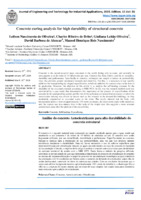 Concrete curing analysis for high durability of structural concrete
Concrete curing analysis for high durability of structural concrete Concrete is the second material most consumed in the world, losing only to water, and currently its
consumption is in the order of 19 billion tons per year. Concrete has been widely used for its versatility,
durability and performance. Specifically in concrete, techniques are sought to reduce its permeability,
since this provides greater mechanical strength and durability. For this, it is necessary to use specific
additives for waterproofing by integral crystallization, which are added to the concrete trace at the time of
its production. However, the objective of this article is to analyze the self-healing concrete for the
durability of the structural concrete according to NBR 9575. In this way the research method used was
constituted by a case study that demonstrates the importance of the process of crystallization of the
concrete in the waterproofing system and the role of the technological rationalization process to which the
construction industry was driven by factors such as the increase in the demand for buildings, be they
residential, commercial or structural works in the cities. The results showed that the body with
incorporated additive showed approximately 13% more resistance, the observation made to the naked eye
and, the rupture was less sinuous than in the body of the simple trait, this suggests a more resistant
cementitious paste after the addition of the crystallizing.
Keywords: Concrete, Self-healing, Crystallizing.
-
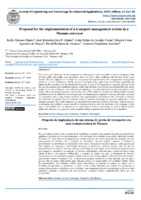 Proposal for the implementation of a transport management system in a Manaus conveyor
Proposal for the implementation of a transport management system in a Manaus conveyor One of the great challenges for the managements of the present time is to obtain a way of management that
provides agility and quality to its procedures, and it was due to these challenges that the idea of this study
started. The main objective of the study was to propose the implementation of a transportation management
system in a carrier in Manaus, with the purpose of computerizing, optimizing, streamlining, organizing and
improving the procedures for the distribution of goods, as well as the formation of company and thus ensure
that all transportation and distribution logistics achieve the efficiency and effectiveness demanded by the carrier
market of the city of Manaus, since information technology is an important tool to remain competitive in the
market. The methodological process used for the study of this study was divided into bibliographical research
and field research, in which the research approach was characterized as qualitative, because the study was based
on a subjective nature, using written narratives, open questionnaires and closed and etc. The nature is research
was classified as applied since the research sought to generate knowledge for practical application in the
shipping company. The results obtained were presented in the proposed solution of the study, with the purpose
of presenting the problems, actions and all the elaborated idea to solve the problems in the company. In this
way, it was evident that it is inherent to an organization to invest in technology, in order to obtain quality,
agility and efficiency in its processes and to guarantee better competitiveness in front of its competitors.
Keywords: System; Management; Technology; Transport; Distribution;
-
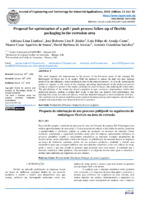 Proposal for optimization of a pull / push process follow-up of flexible packaging in the extrusion area
Proposal for optimization of a pull / push process follow-up of flexible packaging in the extrusion area This work proposes the improvement in the process of the Extrusion sector of the company RS
Embalagens for better use of its setup's. With the proposal to reduce the high loss rate, increase
productivity and efficiency, reduce production costs in the extrusion process. As a result, increasing the
productive capacity in this sector of the company, presenting improvements in the production process
aiming at competitive growth in the market, avoiding raw material wastes, thus reducing the refuse index.
The globalization of the market has forced companies to seek continuous improvements within their
production process, tending to reduce their waste so that they can improve their performance, thus
reducing their setup, loss and cost indexes, which has attracted managers to more production with less .
The condition that the market establishes about products has been growing and companies must be able to
compete and ready to face such demands from their customers.
Keywords: Productivity; Efficiency; Reduction of costs; Logistics;
-
 Implementation of an Industrial Maintenance Services Management Company in the City of Manaus - Amazonas - Brazil
Implementation of an Industrial Maintenance Services Management Company in the City of Manaus - Amazonas - Brazil Abstract— The services segment in recent years has, in a certain way, driven and encouraged the creation and
formalization of small and medium enterprises to provide services and products. In this sense, it is necessary for
the entrepreneur to understand how to implement a company that provides industrial maintenance servi ces. In
order to do so, the main steps of the business planning for the implementation of a service company in the city of
Manaus - AM will be presented. In order to implement a medium or large enterprise, it is necessary to take into
account the basic premises of a business plan that serves as a guiding base for any entrepreneur. Admittedly,
business success depends on the steps and degree of assertiveness of planning in the process of drawing up the
business plan. Within the set of business plan assumptions, it is possible to indicate and approve the objectives,
identify the internal and external risks and generate actions to reduce or even avoid them before the operation of
the company. For the accomplishment of this study we used field research with an e xploratory method, in a
qualitative approach. As an instrument, visits were made to companies and observations of procedures for
setting up a company. The result of this survey was contributed by the owner and the managing partners of the
company. At the end of the research, it was evidenced that companies must establish and follow at least the basic
guidelines of the business plan in order to obtain greater chances of success during its implementation.
Keywords— Business Plan, Entrepreneurship, Industrial Maintenance.
-
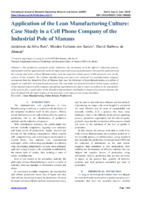 Application of the Lean Manufacturing Culture: Case Study in a Cell Phone Company of the Industrial Pole of Manaus
Application of the Lean Manufacturing Culture: Case Study in a Cell Phone Company of the Industrial Pole of Manaus Abstract— The productive potential of the industries, the increasing need for effective industrial process
management and the opportunity for general improvement of corporate performance, through the application of
the concept and tools of Lean Manufacturing, were the main motivating agents of this research work. In the
context of this scenario, the cellular manufacturing processes were analyzed in a ma nufacturing company
outsourced from the Industrial Pole of Manaus that uses the literature of Lean Manufacturing as a pillar of
support to confection of its functional processes. The case study was structured in three distinct parts: analysis
of the original situation of the company, identifying opportunities for improvement according to the specificities
of the process flow; application of the identified improvements and finally a comparative analysis between the
data obtained with the improvements on the processes with respect to the wastes identified.
Keywords— Lean Manufacturing, Value Stream, Productivity.
-
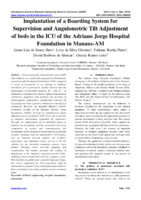 Implantation of a Boarding System for Supervision and Angulometric Tilt Adjustment of beds in the ICU of the Adriano Jorge Hospital Foundation in Manaus-AM
Implantation of a Boarding System for Supervision and Angulometric Tilt Adjustment of beds in the ICU of the Adriano Jorge Hospital Foundation in Manaus-AM Abstract—Concern about the high mortality rates in ICU
beds in Brazil, as a result of the acquisition of Pneumonia
associated with Mechanical Ventilation (PAV), triggered
a series of movements in an attempt to establish
procedures for its prevention. Studies indicate that the
maintenance of decubitus between 30 ° and 45 ° of
inclination, attenuates the invasive effects of mechanical
ventilation equipment and promotes the favoring of
diaphragmatic performance, significantly reducing the
hospitalization time of patients submitted to mechanical
ventilation. However, the Hospital Infection Control
Committee (CCIH) of the Hospital Adriano Jorge
Foundation (FHAJ), through its collaborators, found
difficulties in the regulation of ICU beds, due to the lack
of adequate measurement equipment for regulation.
Through the implantation of an embedded system in
Arduino microcontroller and the association of several
components of sensing and communication, the
development of the inclination measuring device became
possible. Equipped with an alphanumeric LCD display
and an Ethernet network module, the auxiliary
supervision and adjustment device proved to be the
solution for the decubitus regulation process, since
besides allowing local real-time gauging and
visualization, the module provided the sending of
information to the Hospital's internal network (LAN),
enabling general monitoring from the computer screen.
With the built-in audible alert system for improper slopes,
the correct angulation for PAV prevention could be
maintained at optimal levels, eliminating human failures
from carelessness and giving patients greater treatment
safety.
Keywords—Clinical engineering, hospital automation,
pneumonia.
-
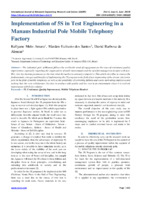 Implementation of 5S in Test Engineering in a Manaus Industrial Pole Mobile Telephony Factory
Implementation of 5S in Test Engineering in a Manaus Industrial Pole Mobile Telephony Factory Abstract— The industrial pole of Manaus follows the worldwide trend of engagement on the issu e of continuous quality
improvement, especially regarding the organization of work environments and the need for managers to do more with less.
This view has become paramount at this time when the market is extremely competitive. This article describes in essence the
fundamentals, concepts and benefits of implementing the 5S program in the field of test engineering of the electro -electronic
pole in the field of mobile telephony, as well as the possibility of correcting failures and waste, motivating employe es and
seeking that the own collaborator, has how to produce with quality and low cost in an environment where it is realized
maintenance of Pcbs for cellular.
Keywords— 5S, Continuous Quality Improvement, Mobile Telephone Handset.
-
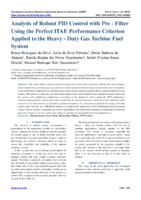 Analysis of Robust PID Control with Pre - Filter Using the Perfect ITAE Performance Criterion Applied to the Heavy - Duty Gas Turbine Fuel System
Analysis of Robust PID Control with Pre - Filter Using the Perfect ITAE Performance Criterion Applied to the Heavy - Duty Gas Turbine Fuel System Abstract— The study of fuel control of the heavy-duty gas turbine arises naturally with the idea of providing a
higher yield to the generation process, which is usually located in the first stage of generation, since the turbine
is one of the main components in a thermoelectric plant along with the generator that is connected directly to the
turbine. PID control is typically one of the most widely used control models in the industry because it provides
the system with satisfactory performance according to the designer's choice using the ITAE performance
criterion and a pre-filter can provide robust control for the system in question, which raises the reliability of the
control even in the presence of variations of plant parameters. It is proposed to perform the sizing of this fuel
control and with the use of MATLAB software to perform the simulation of the performance of the proposed
control system, besides evaluating the control performance for hypothetical situations of parameter variations
that can certainly occur in a system real subject to intemperes and interference from disturbances.
Keywords— Thermoelectric Power Plant, Heavy-Duty Turbine, PID Control.
-
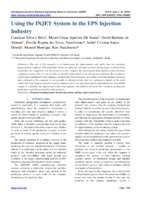 Using the INJET System in the EPS Injection Industry
Using the INJET System in the EPS Injection Industry Abstract— The aim of this research is to demonstrate the improvements and gains that the expanded
polypropylene company (EPS) obtained with the use of the mes-idw injet system in the machines, to obtain levels
of productivity compatible with the resources of the company. By analyzing the data and facts collected in the
company's process flow, it was possible to identify improvement in the operations performed. The productive
control has contributed to the company's productivity with excellence. According to the bibliography based on
data collected in the company, it was possible to identify actions that are satisfactory. Based on the needs
evidenced in the company and the necessary measures that were taken through the implementation of the INJET
system, it is feasible the improvements that were applied, with which it increased the continuous production
performance and the total quality of its products..
Keywords— Production management, monitoring system, quality, improvement tools
-
 Influence of Granulometry of the Small Aggregate on the Permeability of Wall Cement Coating
Influence of Granulometry of the Small Aggregate on the Permeability of Wall Cement Coating Abstract— The performance of the vertical sealing elements is determined by the level of protection to which
they are subjected. Construction processes are changing and cementitious coatings are increasingly taking place
among current construction options. On the other hand, the weather has its increasingly aggressive and more
evident incidence. The performance standard sets the guidelines for seal manufacturers to meet expected quality
standards. Given the above comes the importance of evaluating the best particle size composition to obtain the
ideal mortar manufacture. Water transport mechanisms are the actors in this permeability process with the
effective participation of diffusion and capillarity. The present study proposes observations about the water
absorption of cementitious coatings manufactured with three sand granulometry (fine aggregate). The mixture
containing the fine sand obtained the lowest absorption while the mixture with the highest grain size presented
the highest absorption and the highest flow rates.
Keywords— Particle size, permeability and performance
-
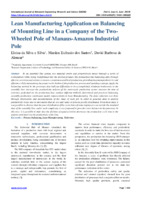 Lean Manufacturing Application on Balancing of Mounting Line in a Company of the TwoWheeled Pole of Manaus-Amazon Industrial Pole
Lean Manufacturing Application on Balancing of Mounting Line in a Company of the TwoWheeled Pole of Manaus-Amazon Industrial Pole Abstract— In an assembly line system, raw material enters and progressively moves through a series of
workstations while being transformed into the desired product. The production line balancing aims through
effective activities and actions to ensure a continuous and level production, providing maximum productivity and
efficiency while maintaining the proper work rhythm of the production process and avoiding wastage. Apply the
balancing method in the processes that indicate difficulties to be accomplished, eliminate bottlenecks in the
assembly line; increase the productivity indexes of the motorcycle production sector; measure the time of
activities performed on the production line; analyze different methods, theoretical and practical balancing
assembly production continuous model; improvements in Lean Manufacturing. The data collection was done
through observation and documentation of the times of each job, in order to generate data to analyze
productivity losses due to movements that do not add value or process poorly distributed. From these data, it
was possible to observe that the poor distribution of the cycle times of some employees was outside the standard
time of the assembly line, under such complexity, it was proposed to provide a new balance in the processes. In
this way, it is possible to infer that the division of equal activities decreases the production cycle time in the
stations and improves the productivity of the line.
Keywords— Process balancing, Lean Manufacturing, Takt time.
-
 Design for Real Temperature and Moisture Analysis on Battery Bank and Nobreak
Design for Real Temperature and Moisture Analysis on Battery Bank and Nobreak Abstract— Keeping track of the temperature and humidity of the nobreaks and battery bank locations helps to
prevent loss of equipment life. Although equipment that makes measurements and controls on site is currently
available, it is difficult to use techniques for temperature and humidity control in real time. This article
implements and describes a temperature and humidity meter along with an automation system for real time
verification of the nobreak and battery bank for industrial use. This design is used as an important tool in
temperature monitoring with the purpose of avoiding the reduction of equipment life causing higher
maintenance costs. Temperature and humidity meters were used to carry out the project, an arduino responsible
for sending the data captured by the sensors to the database, and a web system that shows the data sent by the
arduino in real time. The data obtained through the developed prototype were verified and compared in order to
observe possible temperature changes in industrial environment. The measurements were compared to the
temperatures indicated by the product manufacturer. With this it was attested that the prototype stored the
temperature and humidity data and subsequently sent it to the web system correctly allowing thus a real time
analysis of the temperature and humidity in which the equipment is submitted.
Keywords— Nobreaks; Automation; Battery Bank; Arduino.
-
 Analysis of Failure Modes and Effects of the Process Applied to a White Line Industry
Analysis of Failure Modes and Effects of the Process Applied to a White Line Industry Abstract— Increasingly, factories are forced to increase the reliability of their products and processes, since
nonconformity generates poor quality and waste, interfering with competitiveness. In this way, the current
scenario causes companies to seek out new methods to ensure robust process and product. One of the tools for
continuous process improvement is Failure Mode Analysis and Effects (FMEA), which assists in the prior
detection of failures in a given process, contributing to preventive action and problem correction in an efficient
and agile way. This research intends to show the characteristics of the PFMEA in a case study, applied to the
development of an assembly line of a mixed beverage machine. Finally, all analyzes and ideas addressed by a
multifunctional team are presented through a standard PFMEA form, which allows the reduction of quality
problems related to the product.
Keywords— Quality Management, Failure Modes and Process Effects Analysis (PFMEA), White Line
Industry.
-
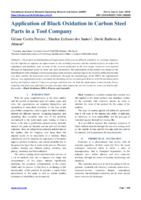 Application of Black Oxidation in Carbon Steel Parts in a Tool Company
Application of Black Oxidation in Carbon Steel Parts in a Tool Company Abstract— The project of implantation and application of the process of black oxidation, in a tooling company,
has the objective to improve an improvement in the assembly processes and the machin ed parts, to reduce the
adjustment and finishing time of some of the services performed in the tool shops, resources were applied
through an implanted sector to carry out such operations. The elaboration of this project was based on the
identification of the problem, which caused delays and excessive expenses due to the logistics of the process that
was done outside the industrial center of Manaus, through the methodology of the PDCA, the implemented
process, was applied in practice, executing the mounting on the two-pole pole devices, with the machined parts,
having the logistics time for 7 days on average, and from now on with the deployment, is done in a few hours,
reducing time and costs, and better serving customers that request the services in shorter term, cost and benefit.
Keywords— Black Oxidation, PDCA, Process and Assembly.
-
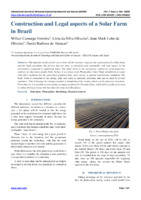 Construction and Legal aspects of a Solar Farm in Brazil
Construction and Legal aspects of a Solar Farm in Brazil Abstract— The objective of this article was to show all the necessary steps for the construction of a Solar Farm
and the legal procedures that involve this new area, so promising and sustainable, with zero impact on the
environment compared to traditional forms. The Solar Farm is not necessarily created on rural properties,
contrary to what many people think. In fact, it is a large-scale Photovoltaic Solar Plant, installed in a region
with ideal conditions for the generation of photovoltaic solar energy in optimal transmission conditions. The
Solar Farm is connected to the energy grid, and starts to generate electricity that can be used by several
customers. This is because the energy executed is transformed into credits, which can be practiced anywhere.
From then on, it is possible to earn quotas of supply produced by Fazenda Solar, which allows profits to be used
to reduce the huge energy bill that takes the sleep of all Brazilians.
Keywords— Solar farm; Photovoltaic; Machining; Electrical network.
-
 Reducing Defective Indexes in the Printing Process of the Computer Plates with the Application of the Welding Paste
Reducing Defective Indexes in the Printing Process of the Computer Plates with the Application of the Welding Paste Abstract— The process of automatic assembly of the smaller components in the plate making industries
represents an important manufacturing activity that influences all stages of production. Thus, it is necessary that
from the beginning of this process there is a technical follow-up regarding the development of the assembly of
the computer boards. The most important process in the manufacture of these plate s is the welding process,
where 70% of the defects occur, are found from the application of weld. In order to minimize the defects that
occurred in the process phase called SMT (Surface Mount Technology) a study was made on the most frequent
defects within this process with the use of 5W2H tools and the Ishikawa Diagram. Thus, the project aims to
reduce defect rates in order to extend product life and continuous improvement in the automatic assembly
process of smaller components.
Keywords— Welding Process; Surface Mount Technology; Solder Paste.
-
 Comparative Analysis between Burnt Cement Floor and Porcelain Floor in a Commercial Area of Manaus-AM
Comparative Analysis between Burnt Cement Floor and Porcelain Floor in a Commercial Area of Manaus-AM Abstract— The field of civil engineering has been evolving over the years, with increasing technological
advances and innovations in several areas. Agility combined with quality are fundamental and must be thought
of in all works, in addition to economic viability. The construction methods and materials for flooring and
flooring available in the market should be analyzed to choose which one is the most suitable for the project
model. Thus, it is questioned what the ideal floor type to be used in a commercial project is aiming at the best
cost-benefit. The objective of this article is to present to the reader simply and directly the advantages and
disadvantages of using burnt cement compared to porcelain in the execution of a work in a commercial area in
the city of Manaus - AM. Given this quantitative research, a comparative analysis was performed between the
execution of two types of floors used in civil construction, which are the burnt cement floor and the porcelaintype ceramic floor. The result of this work indicates that the burnt cement coating has the best cost-benefit
because the execution time is relatively shorter, and the cost is also low when compared to porcelain.
Keywords—Burnt cement; Materials; Porcelain tile; Coating.
-
 Sustainable Alternative: Economic Feasibility Analysis of Using Soil-Cement Brick in the Construction of Popular Housing
Sustainable Alternative: Economic Feasibility Analysis of Using Soil-Cement Brick in the Construction of Popular Housing Abstract—The aim of this study is to present an analysis of the economic viability of using soil-cement bricks in
the construction of popular housing. The study of this material is a way to promote an ecological, social and
economic vision, fundamental for the civil construction. The present study presents a proposal for the use of soilcement brick in the construction of a popular dwelling in accordance with the Manaus City Works Code. The
items are made of Portland cement and ground sand, easy to assemble and at a much lower cost. It was
concluded that the masonry of soil-cement modular bricks has a lower cost when compared to the masonry of
structural ceramic blocks.
Keywords—Sustainability, Soil-Cement Brick, Economic Feasibility
-
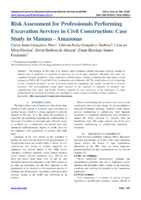 Risk Assessment for Professionals Performing Excavation Services in Civil Construction: Case Study in Manaus - Amazonas
Risk Assessment for Professionals Performing Excavation Services in Civil Construction: Case Study in Manaus - Amazonas Abstract— The purpose of this study is to analyze safety conditions during excavation services, seeking to
identify risks to employees in situations of ignorance or use of safety measures. Therefore, this study was
conducted through a qualitative study, exploratory and descriptive, seeking to diagnose the main impacts of the
adequacy of NR-8, NR-12 and NR-18 in a construction site in Manaus-AM. The results showed lack of signaling
on the excavation perimeter, no use of personal protective equipment and residue around the excavation
perimeter. The nonconformities found imply exposure of the employee to situations of imminent risk,
compromising their safety and health. Training proposals to raise awareness of the importance of safety
standards for the execution of activities can contribute to a safer scenario regarding working conditions.
Keywords— Risk assessment, Construction, Excavation.
-
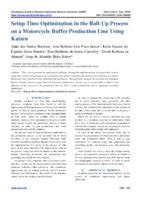 Setup Time Optimization in the Roll-Up Process on a Motorcycle Buffer Production Line Using Kaizen
Setup Time Optimization in the Roll-Up Process on a Motorcycle Buffer Production Line Using Kaizen Abstract— This article presents the application of Kaizen, through the implementation of a device that reduces
setup time in the routing process of a production line of shock absorbers for motorcycles in the factory Amazon
Motocicle Ltda, installed in the industrial hub of Manaus. Through field research the prob lem was identified.
Kaizen reduced process setup time and increased productivity. In this way it was possible to improve the
efficiency of the process in the production line by 50%, to gain productivity and to guarantee customer
satisfaction.
Keywords— Kaizen, Device Implementation, Productivity increase.
-
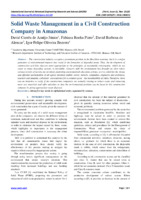 Solid Waste Management in a Civil Construction Company in Amazonas
Solid Waste Management in a Civil Construction Company in Amazonas Abstract— The construction industry occupies a prominent position in the Brazilian economy, but it is a major
generator of environmental impacts that result in the formation of degraded areas. Thus, the development of
construction activities that are more appropriate to the principles of sustainable construction, which do not
cause so many degrading actions, is inevitable. Concern with the environment has brought an alert where
various sectors of society are involved, promoting environmental education actions, so it is called for the strong
and effective participation of all agents involved (public sector, owners, companies, engineers and architects,
teachers and students, collectors’ associations) for a common good - the sustainability of cities. Therefore, there
was an initiative to verify if the construction companies are actually reusing to reduce waste and extracting
more raw materials and offer subsidies so that the environmental problem can be faced in this construction
company by giving appropriate waste disposal.
Keywords— About five key words in alphabetical order, separated by comma.
-
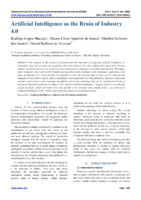 Artificial Intelligence as the Brain of Industry 4.0
Artificial Intelligence as the Brain of Industry 4.0 Abstract— The purpose of this article is to demonstrate the importance of applying artificial intelligence in
enterprises that seek to reach the paradigms that form Industry 4.0, thus unifying the interactivity between
systems, machines and assets to result in a more harmonious production environment and efficient. Nowadays,
many companies have realized the benefits and started investing millions in the technology applications that
make up Industry 4.0 . And with that it is possible to store the relevant data, so they can be analyzed and
managed. It also allows objects, such as machinery, to be controlled over long distances, remotely, without the
need for a face-to-face asset to manage. In addition, there is the technology that can be considered the brain of
the fourth industrial revolution (or Industry 4.0 ) which is Artificial Intelligence , because from it is possible that
certain decisions, which previously were only possible to be resolved with a human being , are resolved by
Artificial Intelligence itself , without any interference from an asset (human being).
Keywords— Artificial Intelligence; Industry 4.0; Revolution Industrial.
-
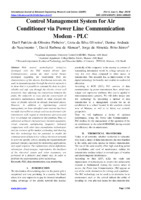 Control Management System for Air Conditioner via Power Line Communication Modem - PLC
Control Management System for Air Conditioner via Power Line Communication Modem - PLC Abstract—With several technological initiatives
developed with the PLC modem (Power Line
Communication), among the most varied themes
developed regarding the relationship from the
characteristics of the electric distribution networks, the
study in transmitting data through the electric network is
to show that it is possible to transmit the data in a fast,
reliable and safe way through the electric circuit well
structured, thus adjusting the connections between the
profit, the reduction of costs and the conservation of
preventive maintenance, mainly in what concerns the
reuse of electric network in already structured places.
However, in addition to implementing control
management, we have identified some reasons that have
not made it possible on a large scale as an alternative for
transmission with regard to interference and noise and
how we pointed out solutions to this problem. Thus, we
addressed technical characteristics between equipment,
circuit structure, multiplexing, frequency, technical
comparisons with other data transmission technologies
and an overview of the market, evaluating and showing
that this technology has the potential to enable the
communication of data in low-voltage electricity networks
to serve the specific school, meeting the requirements for
protocol transfer, especially for monitoring applications,
and rapid response. The explanations about definitions,
advantages, disadvantages, requirements, the interfaces
of the electrical system and other arguments, are
portrayed in a didactic and simple way, in order to
facilitate the understanding of this technology.
Keywords: PLC, data transmission, cost, monitoring
-
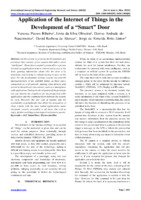 Application of the Internet of Things in the Development of a “Smart” Door
Application of the Internet of Things in the Development of a “Smart” Door Abstract—In this article we propose the development of a
prototype that consists of two systems that make a door
"intelligent". These door-coupled systems allow a person
through an application to have control and access to the
door, gaining information about who the door is by
unlocking and locking it without having to move to the
door. For the development of these systems was used the
microcontrollers of the esp8266 family, as these allow
connection to wi-fi network, making other devices with
access to this network can connect, such as a smartphone
with application. During the development of the prototype
one can observe the complexity for the production of the
application and the communication between the systems
by wi-fi. However, the low cost of systems and the
availability of peripherals that allow the integration of
these systems with the most varied applications, make
electronic security accessible to all those who wish to
enjoy, further enabling technological inclusion in society.
Keywords— IoT, Smart Door, Microcontroller.
-
 Comparative Study of Steel Economy on fck-25 MPa and fck-50 MPa Reinforced Concrete Pillars in a 4-Story Building
Comparative Study of Steel Economy on fck-25 MPa and fck-50 MPa Reinforced Concrete Pillars in a 4-Story Building Abstract— Reinforced concrete is the most widely used building typology in the world, with steel as its most
expensive component. The use of high strength concrete tends to enable the making of slender pieces, its use
directly implies the monetary cost of the work, thus generating savings or increasing the cost. The present work
aims to show the steel consumption for a dimensioned building using 25 MPa and 50 MPa concrete, as well as
to provide results regarding the utilization rates of concrete and steel sections and to draw conclusions about
the mechanical tests performed to obtain the strengths. mentioned above. With the mechanical tests satisfactory
results were obtained for the concrete consistency indexes measured by the slump test and by the axial
compression and tensile compression tests it was possible to demonstrate the expected results. With the use of
C50 concrete, a reduction in steel consumption was achieved mainly for the columns, when compared to the
design made using C25 concrete.
Keywords — Concrete, Software, Cost.
 Concrete curing analysis for high durability of structural concrete Concrete is the second material most consumed in the world, losing only to water, and currently its consumption is in the order of 19 billion tons per year. Concrete has been widely used for its versatility, durability and performance. Specifically in concrete, techniques are sought to reduce its permeability, since this provides greater mechanical strength and durability. For this, it is necessary to use specific additives for waterproofing by integral crystallization, which are added to the concrete trace at the time of its production. However, the objective of this article is to analyze the self-healing concrete for the durability of the structural concrete according to NBR 9575. In this way the research method used was constituted by a case study that demonstrates the importance of the process of crystallization of the concrete in the waterproofing system and the role of the technological rationalization process to which the construction industry was driven by factors such as the increase in the demand for buildings, be they residential, commercial or structural works in the cities. The results showed that the body with incorporated additive showed approximately 13% more resistance, the observation made to the naked eye and, the rupture was less sinuous than in the body of the simple trait, this suggests a more resistant cementitious paste after the addition of the crystallizing. Keywords: Concrete, Self-healing, Crystallizing.
Concrete curing analysis for high durability of structural concrete Concrete is the second material most consumed in the world, losing only to water, and currently its consumption is in the order of 19 billion tons per year. Concrete has been widely used for its versatility, durability and performance. Specifically in concrete, techniques are sought to reduce its permeability, since this provides greater mechanical strength and durability. For this, it is necessary to use specific additives for waterproofing by integral crystallization, which are added to the concrete trace at the time of its production. However, the objective of this article is to analyze the self-healing concrete for the durability of the structural concrete according to NBR 9575. In this way the research method used was constituted by a case study that demonstrates the importance of the process of crystallization of the concrete in the waterproofing system and the role of the technological rationalization process to which the construction industry was driven by factors such as the increase in the demand for buildings, be they residential, commercial or structural works in the cities. The results showed that the body with incorporated additive showed approximately 13% more resistance, the observation made to the naked eye and, the rupture was less sinuous than in the body of the simple trait, this suggests a more resistant cementitious paste after the addition of the crystallizing. Keywords: Concrete, Self-healing, Crystallizing. Proposal for the implementation of a transport management system in a Manaus conveyor One of the great challenges for the managements of the present time is to obtain a way of management that provides agility and quality to its procedures, and it was due to these challenges that the idea of this study started. The main objective of the study was to propose the implementation of a transportation management system in a carrier in Manaus, with the purpose of computerizing, optimizing, streamlining, organizing and improving the procedures for the distribution of goods, as well as the formation of company and thus ensure that all transportation and distribution logistics achieve the efficiency and effectiveness demanded by the carrier market of the city of Manaus, since information technology is an important tool to remain competitive in the market. The methodological process used for the study of this study was divided into bibliographical research and field research, in which the research approach was characterized as qualitative, because the study was based on a subjective nature, using written narratives, open questionnaires and closed and etc. The nature is research was classified as applied since the research sought to generate knowledge for practical application in the shipping company. The results obtained were presented in the proposed solution of the study, with the purpose of presenting the problems, actions and all the elaborated idea to solve the problems in the company. In this way, it was evident that it is inherent to an organization to invest in technology, in order to obtain quality, agility and efficiency in its processes and to guarantee better competitiveness in front of its competitors. Keywords: System; Management; Technology; Transport; Distribution;
Proposal for the implementation of a transport management system in a Manaus conveyor One of the great challenges for the managements of the present time is to obtain a way of management that provides agility and quality to its procedures, and it was due to these challenges that the idea of this study started. The main objective of the study was to propose the implementation of a transportation management system in a carrier in Manaus, with the purpose of computerizing, optimizing, streamlining, organizing and improving the procedures for the distribution of goods, as well as the formation of company and thus ensure that all transportation and distribution logistics achieve the efficiency and effectiveness demanded by the carrier market of the city of Manaus, since information technology is an important tool to remain competitive in the market. The methodological process used for the study of this study was divided into bibliographical research and field research, in which the research approach was characterized as qualitative, because the study was based on a subjective nature, using written narratives, open questionnaires and closed and etc. The nature is research was classified as applied since the research sought to generate knowledge for practical application in the shipping company. The results obtained were presented in the proposed solution of the study, with the purpose of presenting the problems, actions and all the elaborated idea to solve the problems in the company. In this way, it was evident that it is inherent to an organization to invest in technology, in order to obtain quality, agility and efficiency in its processes and to guarantee better competitiveness in front of its competitors. Keywords: System; Management; Technology; Transport; Distribution; Proposal for optimization of a pull / push process follow-up of flexible packaging in the extrusion area This work proposes the improvement in the process of the Extrusion sector of the company RS Embalagens for better use of its setup's. With the proposal to reduce the high loss rate, increase productivity and efficiency, reduce production costs in the extrusion process. As a result, increasing the productive capacity in this sector of the company, presenting improvements in the production process aiming at competitive growth in the market, avoiding raw material wastes, thus reducing the refuse index. The globalization of the market has forced companies to seek continuous improvements within their production process, tending to reduce their waste so that they can improve their performance, thus reducing their setup, loss and cost indexes, which has attracted managers to more production with less . The condition that the market establishes about products has been growing and companies must be able to compete and ready to face such demands from their customers. Keywords: Productivity; Efficiency; Reduction of costs; Logistics;
Proposal for optimization of a pull / push process follow-up of flexible packaging in the extrusion area This work proposes the improvement in the process of the Extrusion sector of the company RS Embalagens for better use of its setup's. With the proposal to reduce the high loss rate, increase productivity and efficiency, reduce production costs in the extrusion process. As a result, increasing the productive capacity in this sector of the company, presenting improvements in the production process aiming at competitive growth in the market, avoiding raw material wastes, thus reducing the refuse index. The globalization of the market has forced companies to seek continuous improvements within their production process, tending to reduce their waste so that they can improve their performance, thus reducing their setup, loss and cost indexes, which has attracted managers to more production with less . The condition that the market establishes about products has been growing and companies must be able to compete and ready to face such demands from their customers. Keywords: Productivity; Efficiency; Reduction of costs; Logistics; Implementation of an Industrial Maintenance Services Management Company in the City of Manaus - Amazonas - Brazil Abstract— The services segment in recent years has, in a certain way, driven and encouraged the creation and formalization of small and medium enterprises to provide services and products. In this sense, it is necessary for the entrepreneur to understand how to implement a company that provides industrial maintenance servi ces. In order to do so, the main steps of the business planning for the implementation of a service company in the city of Manaus - AM will be presented. In order to implement a medium or large enterprise, it is necessary to take into account the basic premises of a business plan that serves as a guiding base for any entrepreneur. Admittedly, business success depends on the steps and degree of assertiveness of planning in the process of drawing up the business plan. Within the set of business plan assumptions, it is possible to indicate and approve the objectives, identify the internal and external risks and generate actions to reduce or even avoid them before the operation of the company. For the accomplishment of this study we used field research with an e xploratory method, in a qualitative approach. As an instrument, visits were made to companies and observations of procedures for setting up a company. The result of this survey was contributed by the owner and the managing partners of the company. At the end of the research, it was evidenced that companies must establish and follow at least the basic guidelines of the business plan in order to obtain greater chances of success during its implementation. Keywords— Business Plan, Entrepreneurship, Industrial Maintenance.
Implementation of an Industrial Maintenance Services Management Company in the City of Manaus - Amazonas - Brazil Abstract— The services segment in recent years has, in a certain way, driven and encouraged the creation and formalization of small and medium enterprises to provide services and products. In this sense, it is necessary for the entrepreneur to understand how to implement a company that provides industrial maintenance servi ces. In order to do so, the main steps of the business planning for the implementation of a service company in the city of Manaus - AM will be presented. In order to implement a medium or large enterprise, it is necessary to take into account the basic premises of a business plan that serves as a guiding base for any entrepreneur. Admittedly, business success depends on the steps and degree of assertiveness of planning in the process of drawing up the business plan. Within the set of business plan assumptions, it is possible to indicate and approve the objectives, identify the internal and external risks and generate actions to reduce or even avoid them before the operation of the company. For the accomplishment of this study we used field research with an e xploratory method, in a qualitative approach. As an instrument, visits were made to companies and observations of procedures for setting up a company. The result of this survey was contributed by the owner and the managing partners of the company. At the end of the research, it was evidenced that companies must establish and follow at least the basic guidelines of the business plan in order to obtain greater chances of success during its implementation. Keywords— Business Plan, Entrepreneurship, Industrial Maintenance. Application of the Lean Manufacturing Culture: Case Study in a Cell Phone Company of the Industrial Pole of Manaus Abstract— The productive potential of the industries, the increasing need for effective industrial process management and the opportunity for general improvement of corporate performance, through the application of the concept and tools of Lean Manufacturing, were the main motivating agents of this research work. In the context of this scenario, the cellular manufacturing processes were analyzed in a ma nufacturing company outsourced from the Industrial Pole of Manaus that uses the literature of Lean Manufacturing as a pillar of support to confection of its functional processes. The case study was structured in three distinct parts: analysis of the original situation of the company, identifying opportunities for improvement according to the specificities of the process flow; application of the identified improvements and finally a comparative analysis between the data obtained with the improvements on the processes with respect to the wastes identified. Keywords— Lean Manufacturing, Value Stream, Productivity.
Application of the Lean Manufacturing Culture: Case Study in a Cell Phone Company of the Industrial Pole of Manaus Abstract— The productive potential of the industries, the increasing need for effective industrial process management and the opportunity for general improvement of corporate performance, through the application of the concept and tools of Lean Manufacturing, were the main motivating agents of this research work. In the context of this scenario, the cellular manufacturing processes were analyzed in a ma nufacturing company outsourced from the Industrial Pole of Manaus that uses the literature of Lean Manufacturing as a pillar of support to confection of its functional processes. The case study was structured in three distinct parts: analysis of the original situation of the company, identifying opportunities for improvement according to the specificities of the process flow; application of the identified improvements and finally a comparative analysis between the data obtained with the improvements on the processes with respect to the wastes identified. Keywords— Lean Manufacturing, Value Stream, Productivity. Implantation of a Boarding System for Supervision and Angulometric Tilt Adjustment of beds in the ICU of the Adriano Jorge Hospital Foundation in Manaus-AM Abstract—Concern about the high mortality rates in ICU beds in Brazil, as a result of the acquisition of Pneumonia associated with Mechanical Ventilation (PAV), triggered a series of movements in an attempt to establish procedures for its prevention. Studies indicate that the maintenance of decubitus between 30 ° and 45 ° of inclination, attenuates the invasive effects of mechanical ventilation equipment and promotes the favoring of diaphragmatic performance, significantly reducing the hospitalization time of patients submitted to mechanical ventilation. However, the Hospital Infection Control Committee (CCIH) of the Hospital Adriano Jorge Foundation (FHAJ), through its collaborators, found difficulties in the regulation of ICU beds, due to the lack of adequate measurement equipment for regulation. Through the implantation of an embedded system in Arduino microcontroller and the association of several components of sensing and communication, the development of the inclination measuring device became possible. Equipped with an alphanumeric LCD display and an Ethernet network module, the auxiliary supervision and adjustment device proved to be the solution for the decubitus regulation process, since besides allowing local real-time gauging and visualization, the module provided the sending of information to the Hospital's internal network (LAN), enabling general monitoring from the computer screen. With the built-in audible alert system for improper slopes, the correct angulation for PAV prevention could be maintained at optimal levels, eliminating human failures from carelessness and giving patients greater treatment safety. Keywords—Clinical engineering, hospital automation, pneumonia.
Implantation of a Boarding System for Supervision and Angulometric Tilt Adjustment of beds in the ICU of the Adriano Jorge Hospital Foundation in Manaus-AM Abstract—Concern about the high mortality rates in ICU beds in Brazil, as a result of the acquisition of Pneumonia associated with Mechanical Ventilation (PAV), triggered a series of movements in an attempt to establish procedures for its prevention. Studies indicate that the maintenance of decubitus between 30 ° and 45 ° of inclination, attenuates the invasive effects of mechanical ventilation equipment and promotes the favoring of diaphragmatic performance, significantly reducing the hospitalization time of patients submitted to mechanical ventilation. However, the Hospital Infection Control Committee (CCIH) of the Hospital Adriano Jorge Foundation (FHAJ), through its collaborators, found difficulties in the regulation of ICU beds, due to the lack of adequate measurement equipment for regulation. Through the implantation of an embedded system in Arduino microcontroller and the association of several components of sensing and communication, the development of the inclination measuring device became possible. Equipped with an alphanumeric LCD display and an Ethernet network module, the auxiliary supervision and adjustment device proved to be the solution for the decubitus regulation process, since besides allowing local real-time gauging and visualization, the module provided the sending of information to the Hospital's internal network (LAN), enabling general monitoring from the computer screen. With the built-in audible alert system for improper slopes, the correct angulation for PAV prevention could be maintained at optimal levels, eliminating human failures from carelessness and giving patients greater treatment safety. Keywords—Clinical engineering, hospital automation, pneumonia. Implementation of 5S in Test Engineering in a Manaus Industrial Pole Mobile Telephony Factory Abstract— The industrial pole of Manaus follows the worldwide trend of engagement on the issu e of continuous quality improvement, especially regarding the organization of work environments and the need for managers to do more with less. This view has become paramount at this time when the market is extremely competitive. This article describes in essence the fundamentals, concepts and benefits of implementing the 5S program in the field of test engineering of the electro -electronic pole in the field of mobile telephony, as well as the possibility of correcting failures and waste, motivating employe es and seeking that the own collaborator, has how to produce with quality and low cost in an environment where it is realized maintenance of Pcbs for cellular. Keywords— 5S, Continuous Quality Improvement, Mobile Telephone Handset.
Implementation of 5S in Test Engineering in a Manaus Industrial Pole Mobile Telephony Factory Abstract— The industrial pole of Manaus follows the worldwide trend of engagement on the issu e of continuous quality improvement, especially regarding the organization of work environments and the need for managers to do more with less. This view has become paramount at this time when the market is extremely competitive. This article describes in essence the fundamentals, concepts and benefits of implementing the 5S program in the field of test engineering of the electro -electronic pole in the field of mobile telephony, as well as the possibility of correcting failures and waste, motivating employe es and seeking that the own collaborator, has how to produce with quality and low cost in an environment where it is realized maintenance of Pcbs for cellular. Keywords— 5S, Continuous Quality Improvement, Mobile Telephone Handset. Analysis of Robust PID Control with Pre - Filter Using the Perfect ITAE Performance Criterion Applied to the Heavy - Duty Gas Turbine Fuel System Abstract— The study of fuel control of the heavy-duty gas turbine arises naturally with the idea of providing a higher yield to the generation process, which is usually located in the first stage of generation, since the turbine is one of the main components in a thermoelectric plant along with the generator that is connected directly to the turbine. PID control is typically one of the most widely used control models in the industry because it provides the system with satisfactory performance according to the designer's choice using the ITAE performance criterion and a pre-filter can provide robust control for the system in question, which raises the reliability of the control even in the presence of variations of plant parameters. It is proposed to perform the sizing of this fuel control and with the use of MATLAB software to perform the simulation of the performance of the proposed control system, besides evaluating the control performance for hypothetical situations of parameter variations that can certainly occur in a system real subject to intemperes and interference from disturbances. Keywords— Thermoelectric Power Plant, Heavy-Duty Turbine, PID Control.
Analysis of Robust PID Control with Pre - Filter Using the Perfect ITAE Performance Criterion Applied to the Heavy - Duty Gas Turbine Fuel System Abstract— The study of fuel control of the heavy-duty gas turbine arises naturally with the idea of providing a higher yield to the generation process, which is usually located in the first stage of generation, since the turbine is one of the main components in a thermoelectric plant along with the generator that is connected directly to the turbine. PID control is typically one of the most widely used control models in the industry because it provides the system with satisfactory performance according to the designer's choice using the ITAE performance criterion and a pre-filter can provide robust control for the system in question, which raises the reliability of the control even in the presence of variations of plant parameters. It is proposed to perform the sizing of this fuel control and with the use of MATLAB software to perform the simulation of the performance of the proposed control system, besides evaluating the control performance for hypothetical situations of parameter variations that can certainly occur in a system real subject to intemperes and interference from disturbances. Keywords— Thermoelectric Power Plant, Heavy-Duty Turbine, PID Control. Using the INJET System in the EPS Injection Industry Abstract— The aim of this research is to demonstrate the improvements and gains that the expanded polypropylene company (EPS) obtained with the use of the mes-idw injet system in the machines, to obtain levels of productivity compatible with the resources of the company. By analyzing the data and facts collected in the company's process flow, it was possible to identify improvement in the operations performed. The productive control has contributed to the company's productivity with excellence. According to the bibliography based on data collected in the company, it was possible to identify actions that are satisfactory. Based on the needs evidenced in the company and the necessary measures that were taken through the implementation of the INJET system, it is feasible the improvements that were applied, with which it increased the continuous production performance and the total quality of its products.. Keywords— Production management, monitoring system, quality, improvement tools
Using the INJET System in the EPS Injection Industry Abstract— The aim of this research is to demonstrate the improvements and gains that the expanded polypropylene company (EPS) obtained with the use of the mes-idw injet system in the machines, to obtain levels of productivity compatible with the resources of the company. By analyzing the data and facts collected in the company's process flow, it was possible to identify improvement in the operations performed. The productive control has contributed to the company's productivity with excellence. According to the bibliography based on data collected in the company, it was possible to identify actions that are satisfactory. Based on the needs evidenced in the company and the necessary measures that were taken through the implementation of the INJET system, it is feasible the improvements that were applied, with which it increased the continuous production performance and the total quality of its products.. Keywords— Production management, monitoring system, quality, improvement tools Influence of Granulometry of the Small Aggregate on the Permeability of Wall Cement Coating Abstract— The performance of the vertical sealing elements is determined by the level of protection to which they are subjected. Construction processes are changing and cementitious coatings are increasingly taking place among current construction options. On the other hand, the weather has its increasingly aggressive and more evident incidence. The performance standard sets the guidelines for seal manufacturers to meet expected quality standards. Given the above comes the importance of evaluating the best particle size composition to obtain the ideal mortar manufacture. Water transport mechanisms are the actors in this permeability process with the effective participation of diffusion and capillarity. The present study proposes observations about the water absorption of cementitious coatings manufactured with three sand granulometry (fine aggregate). The mixture containing the fine sand obtained the lowest absorption while the mixture with the highest grain size presented the highest absorption and the highest flow rates. Keywords— Particle size, permeability and performance
Influence of Granulometry of the Small Aggregate on the Permeability of Wall Cement Coating Abstract— The performance of the vertical sealing elements is determined by the level of protection to which they are subjected. Construction processes are changing and cementitious coatings are increasingly taking place among current construction options. On the other hand, the weather has its increasingly aggressive and more evident incidence. The performance standard sets the guidelines for seal manufacturers to meet expected quality standards. Given the above comes the importance of evaluating the best particle size composition to obtain the ideal mortar manufacture. Water transport mechanisms are the actors in this permeability process with the effective participation of diffusion and capillarity. The present study proposes observations about the water absorption of cementitious coatings manufactured with three sand granulometry (fine aggregate). The mixture containing the fine sand obtained the lowest absorption while the mixture with the highest grain size presented the highest absorption and the highest flow rates. Keywords— Particle size, permeability and performance Lean Manufacturing Application on Balancing of Mounting Line in a Company of the TwoWheeled Pole of Manaus-Amazon Industrial Pole Abstract— In an assembly line system, raw material enters and progressively moves through a series of workstations while being transformed into the desired product. The production line balancing aims through effective activities and actions to ensure a continuous and level production, providing maximum productivity and efficiency while maintaining the proper work rhythm of the production process and avoiding wastage. Apply the balancing method in the processes that indicate difficulties to be accomplished, eliminate bottlenecks in the assembly line; increase the productivity indexes of the motorcycle production sector; measure the time of activities performed on the production line; analyze different methods, theoretical and practical balancing assembly production continuous model; improvements in Lean Manufacturing. The data collection was done through observation and documentation of the times of each job, in order to generate data to analyze productivity losses due to movements that do not add value or process poorly distributed. From these data, it was possible to observe that the poor distribution of the cycle times of some employees was outside the standard time of the assembly line, under such complexity, it was proposed to provide a new balance in the processes. In this way, it is possible to infer that the division of equal activities decreases the production cycle time in the stations and improves the productivity of the line. Keywords— Process balancing, Lean Manufacturing, Takt time.
Lean Manufacturing Application on Balancing of Mounting Line in a Company of the TwoWheeled Pole of Manaus-Amazon Industrial Pole Abstract— In an assembly line system, raw material enters and progressively moves through a series of workstations while being transformed into the desired product. The production line balancing aims through effective activities and actions to ensure a continuous and level production, providing maximum productivity and efficiency while maintaining the proper work rhythm of the production process and avoiding wastage. Apply the balancing method in the processes that indicate difficulties to be accomplished, eliminate bottlenecks in the assembly line; increase the productivity indexes of the motorcycle production sector; measure the time of activities performed on the production line; analyze different methods, theoretical and practical balancing assembly production continuous model; improvements in Lean Manufacturing. The data collection was done through observation and documentation of the times of each job, in order to generate data to analyze productivity losses due to movements that do not add value or process poorly distributed. From these data, it was possible to observe that the poor distribution of the cycle times of some employees was outside the standard time of the assembly line, under such complexity, it was proposed to provide a new balance in the processes. In this way, it is possible to infer that the division of equal activities decreases the production cycle time in the stations and improves the productivity of the line. Keywords— Process balancing, Lean Manufacturing, Takt time. Design for Real Temperature and Moisture Analysis on Battery Bank and Nobreak Abstract— Keeping track of the temperature and humidity of the nobreaks and battery bank locations helps to prevent loss of equipment life. Although equipment that makes measurements and controls on site is currently available, it is difficult to use techniques for temperature and humidity control in real time. This article implements and describes a temperature and humidity meter along with an automation system for real time verification of the nobreak and battery bank for industrial use. This design is used as an important tool in temperature monitoring with the purpose of avoiding the reduction of equipment life causing higher maintenance costs. Temperature and humidity meters were used to carry out the project, an arduino responsible for sending the data captured by the sensors to the database, and a web system that shows the data sent by the arduino in real time. The data obtained through the developed prototype were verified and compared in order to observe possible temperature changes in industrial environment. The measurements were compared to the temperatures indicated by the product manufacturer. With this it was attested that the prototype stored the temperature and humidity data and subsequently sent it to the web system correctly allowing thus a real time analysis of the temperature and humidity in which the equipment is submitted. Keywords— Nobreaks; Automation; Battery Bank; Arduino.
Design for Real Temperature and Moisture Analysis on Battery Bank and Nobreak Abstract— Keeping track of the temperature and humidity of the nobreaks and battery bank locations helps to prevent loss of equipment life. Although equipment that makes measurements and controls on site is currently available, it is difficult to use techniques for temperature and humidity control in real time. This article implements and describes a temperature and humidity meter along with an automation system for real time verification of the nobreak and battery bank for industrial use. This design is used as an important tool in temperature monitoring with the purpose of avoiding the reduction of equipment life causing higher maintenance costs. Temperature and humidity meters were used to carry out the project, an arduino responsible for sending the data captured by the sensors to the database, and a web system that shows the data sent by the arduino in real time. The data obtained through the developed prototype were verified and compared in order to observe possible temperature changes in industrial environment. The measurements were compared to the temperatures indicated by the product manufacturer. With this it was attested that the prototype stored the temperature and humidity data and subsequently sent it to the web system correctly allowing thus a real time analysis of the temperature and humidity in which the equipment is submitted. Keywords— Nobreaks; Automation; Battery Bank; Arduino. Analysis of Failure Modes and Effects of the Process Applied to a White Line Industry Abstract— Increasingly, factories are forced to increase the reliability of their products and processes, since nonconformity generates poor quality and waste, interfering with competitiveness. In this way, the current scenario causes companies to seek out new methods to ensure robust process and product. One of the tools for continuous process improvement is Failure Mode Analysis and Effects (FMEA), which assists in the prior detection of failures in a given process, contributing to preventive action and problem correction in an efficient and agile way. This research intends to show the characteristics of the PFMEA in a case study, applied to the development of an assembly line of a mixed beverage machine. Finally, all analyzes and ideas addressed by a multifunctional team are presented through a standard PFMEA form, which allows the reduction of quality problems related to the product. Keywords— Quality Management, Failure Modes and Process Effects Analysis (PFMEA), White Line Industry.
Analysis of Failure Modes and Effects of the Process Applied to a White Line Industry Abstract— Increasingly, factories are forced to increase the reliability of their products and processes, since nonconformity generates poor quality and waste, interfering with competitiveness. In this way, the current scenario causes companies to seek out new methods to ensure robust process and product. One of the tools for continuous process improvement is Failure Mode Analysis and Effects (FMEA), which assists in the prior detection of failures in a given process, contributing to preventive action and problem correction in an efficient and agile way. This research intends to show the characteristics of the PFMEA in a case study, applied to the development of an assembly line of a mixed beverage machine. Finally, all analyzes and ideas addressed by a multifunctional team are presented through a standard PFMEA form, which allows the reduction of quality problems related to the product. Keywords— Quality Management, Failure Modes and Process Effects Analysis (PFMEA), White Line Industry. Application of Black Oxidation in Carbon Steel Parts in a Tool Company Abstract— The project of implantation and application of the process of black oxidation, in a tooling company, has the objective to improve an improvement in the assembly processes and the machin ed parts, to reduce the adjustment and finishing time of some of the services performed in the tool shops, resources were applied through an implanted sector to carry out such operations. The elaboration of this project was based on the identification of the problem, which caused delays and excessive expenses due to the logistics of the process that was done outside the industrial center of Manaus, through the methodology of the PDCA, the implemented process, was applied in practice, executing the mounting on the two-pole pole devices, with the machined parts, having the logistics time for 7 days on average, and from now on with the deployment, is done in a few hours, reducing time and costs, and better serving customers that request the services in shorter term, cost and benefit. Keywords— Black Oxidation, PDCA, Process and Assembly.
Application of Black Oxidation in Carbon Steel Parts in a Tool Company Abstract— The project of implantation and application of the process of black oxidation, in a tooling company, has the objective to improve an improvement in the assembly processes and the machin ed parts, to reduce the adjustment and finishing time of some of the services performed in the tool shops, resources were applied through an implanted sector to carry out such operations. The elaboration of this project was based on the identification of the problem, which caused delays and excessive expenses due to the logistics of the process that was done outside the industrial center of Manaus, through the methodology of the PDCA, the implemented process, was applied in practice, executing the mounting on the two-pole pole devices, with the machined parts, having the logistics time for 7 days on average, and from now on with the deployment, is done in a few hours, reducing time and costs, and better serving customers that request the services in shorter term, cost and benefit. Keywords— Black Oxidation, PDCA, Process and Assembly. Construction and Legal aspects of a Solar Farm in Brazil Abstract— The objective of this article was to show all the necessary steps for the construction of a Solar Farm and the legal procedures that involve this new area, so promising and sustainable, with zero impact on the environment compared to traditional forms. The Solar Farm is not necessarily created on rural properties, contrary to what many people think. In fact, it is a large-scale Photovoltaic Solar Plant, installed in a region with ideal conditions for the generation of photovoltaic solar energy in optimal transmission conditions. The Solar Farm is connected to the energy grid, and starts to generate electricity that can be used by several customers. This is because the energy executed is transformed into credits, which can be practiced anywhere. From then on, it is possible to earn quotas of supply produced by Fazenda Solar, which allows profits to be used to reduce the huge energy bill that takes the sleep of all Brazilians. Keywords— Solar farm; Photovoltaic; Machining; Electrical network.
Construction and Legal aspects of a Solar Farm in Brazil Abstract— The objective of this article was to show all the necessary steps for the construction of a Solar Farm and the legal procedures that involve this new area, so promising and sustainable, with zero impact on the environment compared to traditional forms. The Solar Farm is not necessarily created on rural properties, contrary to what many people think. In fact, it is a large-scale Photovoltaic Solar Plant, installed in a region with ideal conditions for the generation of photovoltaic solar energy in optimal transmission conditions. The Solar Farm is connected to the energy grid, and starts to generate electricity that can be used by several customers. This is because the energy executed is transformed into credits, which can be practiced anywhere. From then on, it is possible to earn quotas of supply produced by Fazenda Solar, which allows profits to be used to reduce the huge energy bill that takes the sleep of all Brazilians. Keywords— Solar farm; Photovoltaic; Machining; Electrical network. Reducing Defective Indexes in the Printing Process of the Computer Plates with the Application of the Welding Paste Abstract— The process of automatic assembly of the smaller components in the plate making industries represents an important manufacturing activity that influences all stages of production. Thus, it is necessary that from the beginning of this process there is a technical follow-up regarding the development of the assembly of the computer boards. The most important process in the manufacture of these plate s is the welding process, where 70% of the defects occur, are found from the application of weld. In order to minimize the defects that occurred in the process phase called SMT (Surface Mount Technology) a study was made on the most frequent defects within this process with the use of 5W2H tools and the Ishikawa Diagram. Thus, the project aims to reduce defect rates in order to extend product life and continuous improvement in the automatic assembly process of smaller components. Keywords— Welding Process; Surface Mount Technology; Solder Paste.
Reducing Defective Indexes in the Printing Process of the Computer Plates with the Application of the Welding Paste Abstract— The process of automatic assembly of the smaller components in the plate making industries represents an important manufacturing activity that influences all stages of production. Thus, it is necessary that from the beginning of this process there is a technical follow-up regarding the development of the assembly of the computer boards. The most important process in the manufacture of these plate s is the welding process, where 70% of the defects occur, are found from the application of weld. In order to minimize the defects that occurred in the process phase called SMT (Surface Mount Technology) a study was made on the most frequent defects within this process with the use of 5W2H tools and the Ishikawa Diagram. Thus, the project aims to reduce defect rates in order to extend product life and continuous improvement in the automatic assembly process of smaller components. Keywords— Welding Process; Surface Mount Technology; Solder Paste. Comparative Analysis between Burnt Cement Floor and Porcelain Floor in a Commercial Area of Manaus-AM Abstract— The field of civil engineering has been evolving over the years, with increasing technological advances and innovations in several areas. Agility combined with quality are fundamental and must be thought of in all works, in addition to economic viability. The construction methods and materials for flooring and flooring available in the market should be analyzed to choose which one is the most suitable for the project model. Thus, it is questioned what the ideal floor type to be used in a commercial project is aiming at the best cost-benefit. The objective of this article is to present to the reader simply and directly the advantages and disadvantages of using burnt cement compared to porcelain in the execution of a work in a commercial area in the city of Manaus - AM. Given this quantitative research, a comparative analysis was performed between the execution of two types of floors used in civil construction, which are the burnt cement floor and the porcelaintype ceramic floor. The result of this work indicates that the burnt cement coating has the best cost-benefit because the execution time is relatively shorter, and the cost is also low when compared to porcelain. Keywords—Burnt cement; Materials; Porcelain tile; Coating.
Comparative Analysis between Burnt Cement Floor and Porcelain Floor in a Commercial Area of Manaus-AM Abstract— The field of civil engineering has been evolving over the years, with increasing technological advances and innovations in several areas. Agility combined with quality are fundamental and must be thought of in all works, in addition to economic viability. The construction methods and materials for flooring and flooring available in the market should be analyzed to choose which one is the most suitable for the project model. Thus, it is questioned what the ideal floor type to be used in a commercial project is aiming at the best cost-benefit. The objective of this article is to present to the reader simply and directly the advantages and disadvantages of using burnt cement compared to porcelain in the execution of a work in a commercial area in the city of Manaus - AM. Given this quantitative research, a comparative analysis was performed between the execution of two types of floors used in civil construction, which are the burnt cement floor and the porcelaintype ceramic floor. The result of this work indicates that the burnt cement coating has the best cost-benefit because the execution time is relatively shorter, and the cost is also low when compared to porcelain. Keywords—Burnt cement; Materials; Porcelain tile; Coating. Sustainable Alternative: Economic Feasibility Analysis of Using Soil-Cement Brick in the Construction of Popular Housing Abstract—The aim of this study is to present an analysis of the economic viability of using soil-cement bricks in the construction of popular housing. The study of this material is a way to promote an ecological, social and economic vision, fundamental for the civil construction. The present study presents a proposal for the use of soilcement brick in the construction of a popular dwelling in accordance with the Manaus City Works Code. The items are made of Portland cement and ground sand, easy to assemble and at a much lower cost. It was concluded that the masonry of soil-cement modular bricks has a lower cost when compared to the masonry of structural ceramic blocks. Keywords—Sustainability, Soil-Cement Brick, Economic Feasibility
Sustainable Alternative: Economic Feasibility Analysis of Using Soil-Cement Brick in the Construction of Popular Housing Abstract—The aim of this study is to present an analysis of the economic viability of using soil-cement bricks in the construction of popular housing. The study of this material is a way to promote an ecological, social and economic vision, fundamental for the civil construction. The present study presents a proposal for the use of soilcement brick in the construction of a popular dwelling in accordance with the Manaus City Works Code. The items are made of Portland cement and ground sand, easy to assemble and at a much lower cost. It was concluded that the masonry of soil-cement modular bricks has a lower cost when compared to the masonry of structural ceramic blocks. Keywords—Sustainability, Soil-Cement Brick, Economic Feasibility Risk Assessment for Professionals Performing Excavation Services in Civil Construction: Case Study in Manaus - Amazonas Abstract— The purpose of this study is to analyze safety conditions during excavation services, seeking to identify risks to employees in situations of ignorance or use of safety measures. Therefore, this study was conducted through a qualitative study, exploratory and descriptive, seeking to diagnose the main impacts of the adequacy of NR-8, NR-12 and NR-18 in a construction site in Manaus-AM. The results showed lack of signaling on the excavation perimeter, no use of personal protective equipment and residue around the excavation perimeter. The nonconformities found imply exposure of the employee to situations of imminent risk, compromising their safety and health. Training proposals to raise awareness of the importance of safety standards for the execution of activities can contribute to a safer scenario regarding working conditions. Keywords— Risk assessment, Construction, Excavation.
Risk Assessment for Professionals Performing Excavation Services in Civil Construction: Case Study in Manaus - Amazonas Abstract— The purpose of this study is to analyze safety conditions during excavation services, seeking to identify risks to employees in situations of ignorance or use of safety measures. Therefore, this study was conducted through a qualitative study, exploratory and descriptive, seeking to diagnose the main impacts of the adequacy of NR-8, NR-12 and NR-18 in a construction site in Manaus-AM. The results showed lack of signaling on the excavation perimeter, no use of personal protective equipment and residue around the excavation perimeter. The nonconformities found imply exposure of the employee to situations of imminent risk, compromising their safety and health. Training proposals to raise awareness of the importance of safety standards for the execution of activities can contribute to a safer scenario regarding working conditions. Keywords— Risk assessment, Construction, Excavation. Setup Time Optimization in the Roll-Up Process on a Motorcycle Buffer Production Line Using Kaizen Abstract— This article presents the application of Kaizen, through the implementation of a device that reduces setup time in the routing process of a production line of shock absorbers for motorcycles in the factory Amazon Motocicle Ltda, installed in the industrial hub of Manaus. Through field research the prob lem was identified. Kaizen reduced process setup time and increased productivity. In this way it was possible to improve the efficiency of the process in the production line by 50%, to gain productivity and to guarantee customer satisfaction. Keywords— Kaizen, Device Implementation, Productivity increase.
Setup Time Optimization in the Roll-Up Process on a Motorcycle Buffer Production Line Using Kaizen Abstract— This article presents the application of Kaizen, through the implementation of a device that reduces setup time in the routing process of a production line of shock absorbers for motorcycles in the factory Amazon Motocicle Ltda, installed in the industrial hub of Manaus. Through field research the prob lem was identified. Kaizen reduced process setup time and increased productivity. In this way it was possible to improve the efficiency of the process in the production line by 50%, to gain productivity and to guarantee customer satisfaction. Keywords— Kaizen, Device Implementation, Productivity increase. Solid Waste Management in a Civil Construction Company in Amazonas Abstract— The construction industry occupies a prominent position in the Brazilian economy, but it is a major generator of environmental impacts that result in the formation of degraded areas. Thus, the development of construction activities that are more appropriate to the principles of sustainable construction, which do not cause so many degrading actions, is inevitable. Concern with the environment has brought an alert where various sectors of society are involved, promoting environmental education actions, so it is called for the strong and effective participation of all agents involved (public sector, owners, companies, engineers and architects, teachers and students, collectors’ associations) for a common good - the sustainability of cities. Therefore, there was an initiative to verify if the construction companies are actually reusing to reduce waste and extracting more raw materials and offer subsidies so that the environmental problem can be faced in this construction company by giving appropriate waste disposal. Keywords— About five key words in alphabetical order, separated by comma.
Solid Waste Management in a Civil Construction Company in Amazonas Abstract— The construction industry occupies a prominent position in the Brazilian economy, but it is a major generator of environmental impacts that result in the formation of degraded areas. Thus, the development of construction activities that are more appropriate to the principles of sustainable construction, which do not cause so many degrading actions, is inevitable. Concern with the environment has brought an alert where various sectors of society are involved, promoting environmental education actions, so it is called for the strong and effective participation of all agents involved (public sector, owners, companies, engineers and architects, teachers and students, collectors’ associations) for a common good - the sustainability of cities. Therefore, there was an initiative to verify if the construction companies are actually reusing to reduce waste and extracting more raw materials and offer subsidies so that the environmental problem can be faced in this construction company by giving appropriate waste disposal. Keywords— About five key words in alphabetical order, separated by comma. Artificial Intelligence as the Brain of Industry 4.0 Abstract— The purpose of this article is to demonstrate the importance of applying artificial intelligence in enterprises that seek to reach the paradigms that form Industry 4.0, thus unifying the interactivity between systems, machines and assets to result in a more harmonious production environment and efficient. Nowadays, many companies have realized the benefits and started investing millions in the technology applications that make up Industry 4.0 . And with that it is possible to store the relevant data, so they can be analyzed and managed. It also allows objects, such as machinery, to be controlled over long distances, remotely, without the need for a face-to-face asset to manage. In addition, there is the technology that can be considered the brain of the fourth industrial revolution (or Industry 4.0 ) which is Artificial Intelligence , because from it is possible that certain decisions, which previously were only possible to be resolved with a human being , are resolved by Artificial Intelligence itself , without any interference from an asset (human being). Keywords— Artificial Intelligence; Industry 4.0; Revolution Industrial.
Artificial Intelligence as the Brain of Industry 4.0 Abstract— The purpose of this article is to demonstrate the importance of applying artificial intelligence in enterprises that seek to reach the paradigms that form Industry 4.0, thus unifying the interactivity between systems, machines and assets to result in a more harmonious production environment and efficient. Nowadays, many companies have realized the benefits and started investing millions in the technology applications that make up Industry 4.0 . And with that it is possible to store the relevant data, so they can be analyzed and managed. It also allows objects, such as machinery, to be controlled over long distances, remotely, without the need for a face-to-face asset to manage. In addition, there is the technology that can be considered the brain of the fourth industrial revolution (or Industry 4.0 ) which is Artificial Intelligence , because from it is possible that certain decisions, which previously were only possible to be resolved with a human being , are resolved by Artificial Intelligence itself , without any interference from an asset (human being). Keywords— Artificial Intelligence; Industry 4.0; Revolution Industrial. Control Management System for Air Conditioner via Power Line Communication Modem - PLC Abstract—With several technological initiatives developed with the PLC modem (Power Line Communication), among the most varied themes developed regarding the relationship from the characteristics of the electric distribution networks, the study in transmitting data through the electric network is to show that it is possible to transmit the data in a fast, reliable and safe way through the electric circuit well structured, thus adjusting the connections between the profit, the reduction of costs and the conservation of preventive maintenance, mainly in what concerns the reuse of electric network in already structured places. However, in addition to implementing control management, we have identified some reasons that have not made it possible on a large scale as an alternative for transmission with regard to interference and noise and how we pointed out solutions to this problem. Thus, we addressed technical characteristics between equipment, circuit structure, multiplexing, frequency, technical comparisons with other data transmission technologies and an overview of the market, evaluating and showing that this technology has the potential to enable the communication of data in low-voltage electricity networks to serve the specific school, meeting the requirements for protocol transfer, especially for monitoring applications, and rapid response. The explanations about definitions, advantages, disadvantages, requirements, the interfaces of the electrical system and other arguments, are portrayed in a didactic and simple way, in order to facilitate the understanding of this technology. Keywords: PLC, data transmission, cost, monitoring
Control Management System for Air Conditioner via Power Line Communication Modem - PLC Abstract—With several technological initiatives developed with the PLC modem (Power Line Communication), among the most varied themes developed regarding the relationship from the characteristics of the electric distribution networks, the study in transmitting data through the electric network is to show that it is possible to transmit the data in a fast, reliable and safe way through the electric circuit well structured, thus adjusting the connections between the profit, the reduction of costs and the conservation of preventive maintenance, mainly in what concerns the reuse of electric network in already structured places. However, in addition to implementing control management, we have identified some reasons that have not made it possible on a large scale as an alternative for transmission with regard to interference and noise and how we pointed out solutions to this problem. Thus, we addressed technical characteristics between equipment, circuit structure, multiplexing, frequency, technical comparisons with other data transmission technologies and an overview of the market, evaluating and showing that this technology has the potential to enable the communication of data in low-voltage electricity networks to serve the specific school, meeting the requirements for protocol transfer, especially for monitoring applications, and rapid response. The explanations about definitions, advantages, disadvantages, requirements, the interfaces of the electrical system and other arguments, are portrayed in a didactic and simple way, in order to facilitate the understanding of this technology. Keywords: PLC, data transmission, cost, monitoring Application of the Internet of Things in the Development of a “Smart” Door Abstract—In this article we propose the development of a prototype that consists of two systems that make a door "intelligent". These door-coupled systems allow a person through an application to have control and access to the door, gaining information about who the door is by unlocking and locking it without having to move to the door. For the development of these systems was used the microcontrollers of the esp8266 family, as these allow connection to wi-fi network, making other devices with access to this network can connect, such as a smartphone with application. During the development of the prototype one can observe the complexity for the production of the application and the communication between the systems by wi-fi. However, the low cost of systems and the availability of peripherals that allow the integration of these systems with the most varied applications, make electronic security accessible to all those who wish to enjoy, further enabling technological inclusion in society. Keywords— IoT, Smart Door, Microcontroller.
Application of the Internet of Things in the Development of a “Smart” Door Abstract—In this article we propose the development of a prototype that consists of two systems that make a door "intelligent". These door-coupled systems allow a person through an application to have control and access to the door, gaining information about who the door is by unlocking and locking it without having to move to the door. For the development of these systems was used the microcontrollers of the esp8266 family, as these allow connection to wi-fi network, making other devices with access to this network can connect, such as a smartphone with application. During the development of the prototype one can observe the complexity for the production of the application and the communication between the systems by wi-fi. However, the low cost of systems and the availability of peripherals that allow the integration of these systems with the most varied applications, make electronic security accessible to all those who wish to enjoy, further enabling technological inclusion in society. Keywords— IoT, Smart Door, Microcontroller. Comparative Study of Steel Economy on fck-25 MPa and fck-50 MPa Reinforced Concrete Pillars in a 4-Story Building Abstract— Reinforced concrete is the most widely used building typology in the world, with steel as its most expensive component. The use of high strength concrete tends to enable the making of slender pieces, its use directly implies the monetary cost of the work, thus generating savings or increasing the cost. The present work aims to show the steel consumption for a dimensioned building using 25 MPa and 50 MPa concrete, as well as to provide results regarding the utilization rates of concrete and steel sections and to draw conclusions about the mechanical tests performed to obtain the strengths. mentioned above. With the mechanical tests satisfactory results were obtained for the concrete consistency indexes measured by the slump test and by the axial compression and tensile compression tests it was possible to demonstrate the expected results. With the use of C50 concrete, a reduction in steel consumption was achieved mainly for the columns, when compared to the design made using C25 concrete. Keywords — Concrete, Software, Cost.
Comparative Study of Steel Economy on fck-25 MPa and fck-50 MPa Reinforced Concrete Pillars in a 4-Story Building Abstract— Reinforced concrete is the most widely used building typology in the world, with steel as its most expensive component. The use of high strength concrete tends to enable the making of slender pieces, its use directly implies the monetary cost of the work, thus generating savings or increasing the cost. The present work aims to show the steel consumption for a dimensioned building using 25 MPa and 50 MPa concrete, as well as to provide results regarding the utilization rates of concrete and steel sections and to draw conclusions about the mechanical tests performed to obtain the strengths. mentioned above. With the mechanical tests satisfactory results were obtained for the concrete consistency indexes measured by the slump test and by the axial compression and tensile compression tests it was possible to demonstrate the expected results. With the use of C50 concrete, a reduction in steel consumption was achieved mainly for the columns, when compared to the design made using C25 concrete. Keywords — Concrete, Software, Cost.